Please visit http://participation.cymru/en/blog to read our latest posts.
If you were a subscriber here – don’t worry, we’ve automatically moved your subscription over to our new website.
Thank you

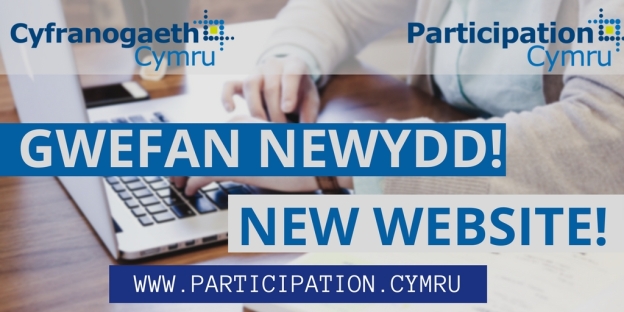
Please visit http://participation.cymru/en/blog to read our latest posts.
If you were a subscriber here – don’t worry, we’ve automatically moved your subscription over to our new website.
Thank you
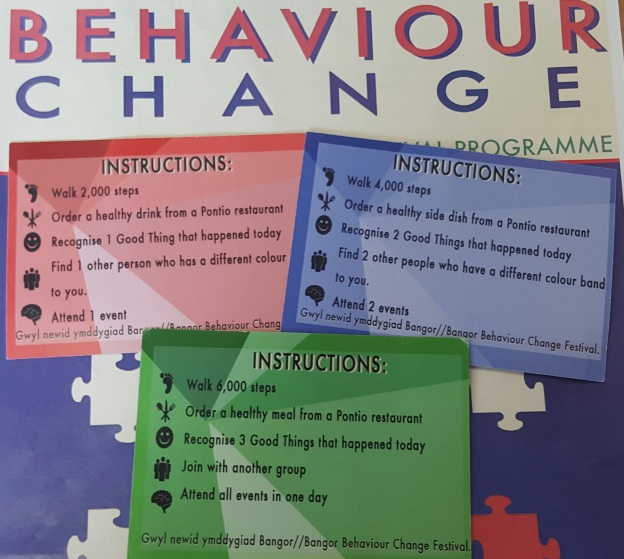
The most recent North Wales Participation Network was held as part of a wider event – the Festival of Behaviour Change which took place in Pontio, Bangor University and was organised in partnership with Wales Audit Office and Good Practice Wales.
The Behaviour Change Festival was aimed at people with an interest in social change or innovation in roles in healthcare, education, local and national government and the voluntary sector including:
A major part of the festival was the gamification aspect to each day. If you read our most recent newsletter, this was featured as the ‘Method of the Month’. Let’s explore how this works in more detail:
Each participant had 3 ‘game cards’ inside the delegate pack that was given out upon arrival. Each card either represented ‘easy’, ‘medium’ or ‘hard’ and had a list of challenges to complete throughout the day. When you complete a challenge, you get a stamp on your game card and a completed card wins a small prize.
I like a challenge, so I went straight to the card labelled ‘hard’ and had a look at what I’d need to do in order to win a prize:
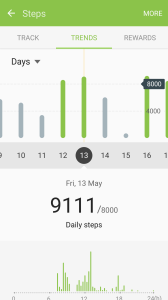 It wasn’t as easy as simply asking for a stamp, you needed to provide proof…
It wasn’t as easy as simply asking for a stamp, you needed to provide proof…
I used a step-counter app on my phone to keep track of my footsteps (I’d already walked to the venue so was over half-way towards the target before the event began), they had pedometers available too.
At lunchtime, I took a photograph of my receipt and my meal and was awarded a stamp for ‘ordering a healthy meal’ 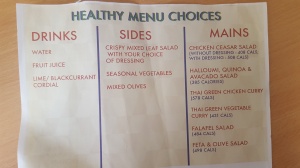
I also intended to use photos as proof for recognising positive things that happened – the sun was shining, our network event was very well attended and we had an excellent discussion – I sadly didn’t gain the stamp for this challenge, as I was busy facilitating the network event and only had a chance to take 1 photograph so missed out due to lack of evidence!
In order to join with another group, there were various colours of wristbands in our delegate packs – 4 different colours in total. This could be proved by taking a photo of the different coloured wristbands.
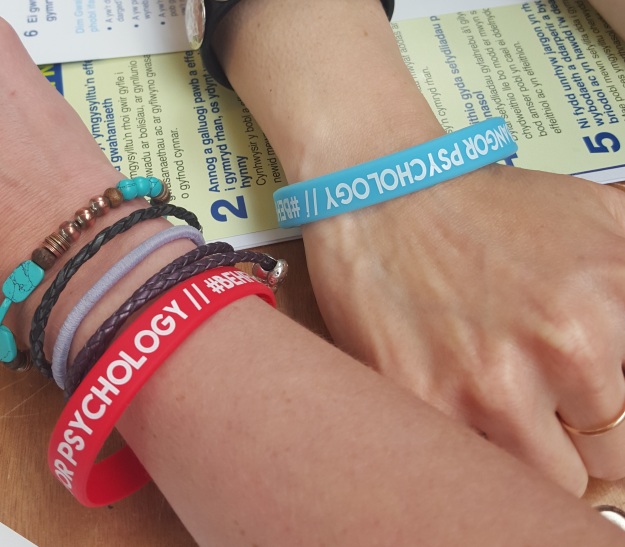
To prove you attended all the events in one day, after leaving a session the participants who were playing the game could get a stamp for their card.
Although I didn’t gain every stamp in order to win a prize, this activity was a very fun way to participate in addition to the interesting sessions taking place as part of the festival.
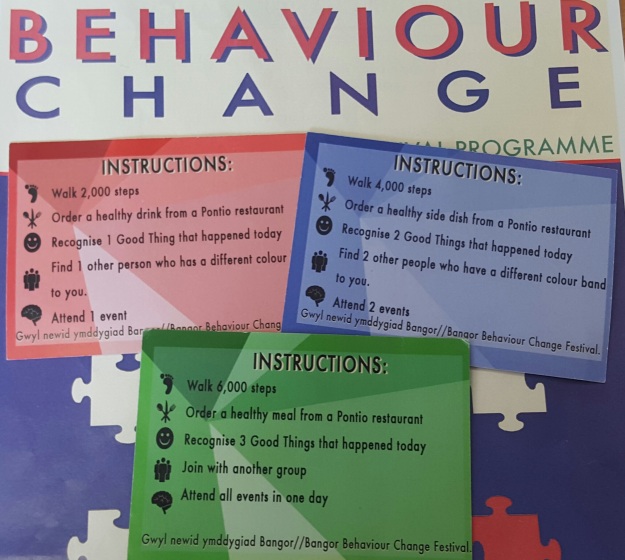
Apply this game to your own life
This technique is incredibly motivational if you apply it to your everyday life. There is a website and mobile app I’ve discovered called Habitica which turns your life into an RPG (role-playing-game). You set your own tasks and goals, rate their difficulty and when you complete them your character is rewarded! Be warned, if you don’t complete your tasks, this will harm your character’s health and you will have to work harder to bring it back up again.
Random acts of kindness
In addition to the game cards, inside our delegate pack was information about ‘random acts of kindness’ …and some stickers. The information sheet suggested these possible random acts of kindness:
The game was to use the stickers provided to identify your random acts of kindness. The aim of this game is to create a positive experience for everyone. Small, simple and commonly spontaneous acts of kindness, often performed to strangers, have been shown to significantly increase feelings of happiness for both the giver and receiver. Additionally, consciously reflecting upon such acts is linked to a reduction in negative emotions and is thought to enhance an optimistic outlook.
Research has shown that random acts of kindness can be an effective way in which to enhance your social and emotional wellbeing, which is further connected to relationship skills, responsible decision-making, self-esteem and self-awareness.
Have you used any gamification activities with service users, or have you used a gamification app for personal behaviour change goals? Why might random acts of kindness work for you? Please let us know in the comments below and join our discussion.
– Sarah

In the Participation Cymru team we love spending time outdoors and the opportunity of holding a network in the open air is an idea we’ve thrown around for a while.
So, just after the early May Bank Holiday weekend we held our first ever practitioner network event that took place in nature with the help of Tom Moses from Pembrokeshire Coast National Park. Here is a summary what happened:
Firstly, the weather was absolutely glorious!
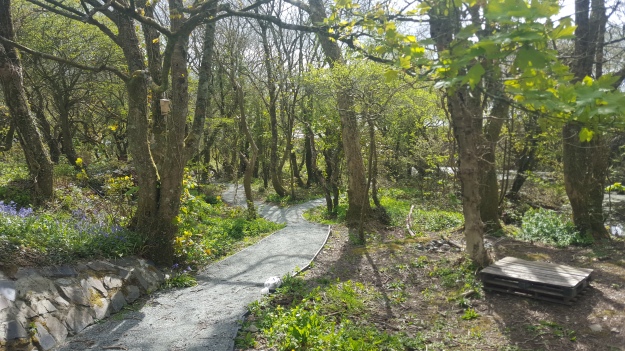
Not even a hint of rain

Tom started the fire earlier that morning, so hot tea and coffee was served upon arrival.
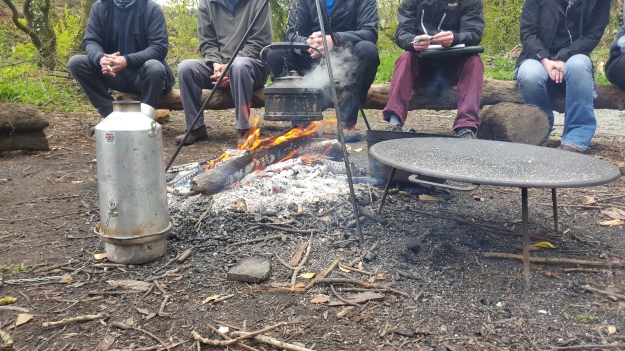
Jill Simpson, from Pembrokeshire Coast National Park showed us this beautiful, tactile piece of community made woodland furniture (it’s so much more than just a bench) that was designed and created by local young people.
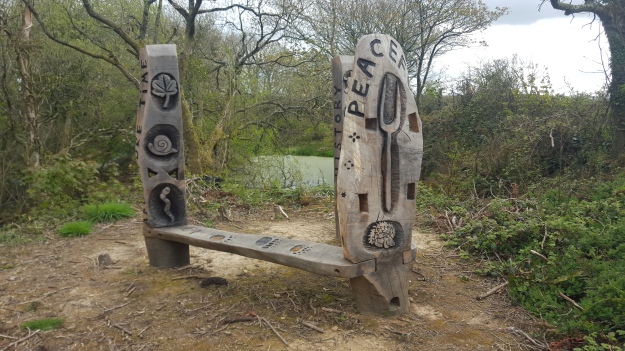
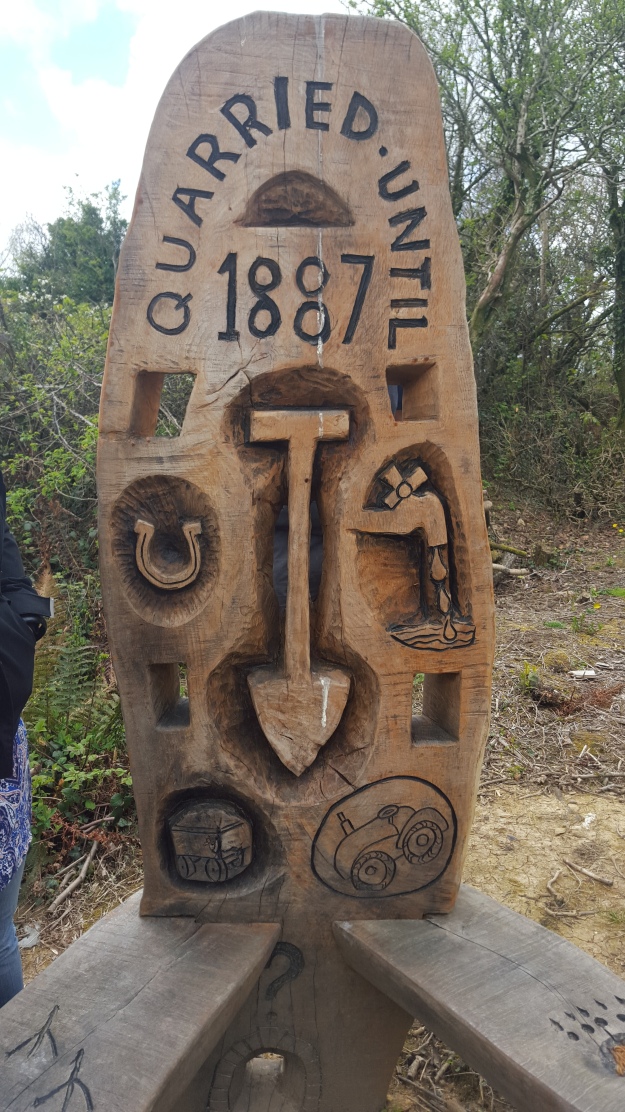
Matt, a volunteer for Pembrokeshire Coast took us for a walk along a bridleway where we learned map reading and basic orienteering skills.
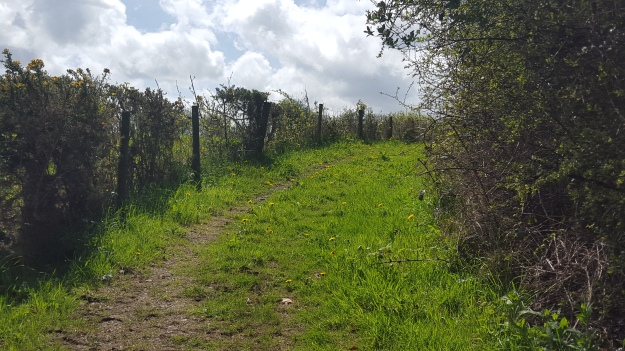
Along the way we met some inquisitive young cattle who were very keen to say hello
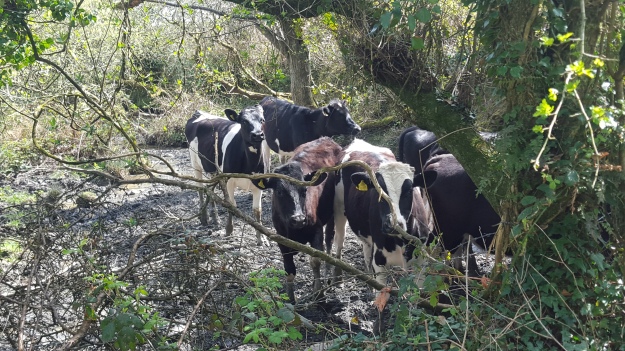
It’s possible to make tea from various plants, roots and fungi found in the woodland (but never eat anything you’ve picked in the wild unless you’re absolutely sure that it’s safe!)
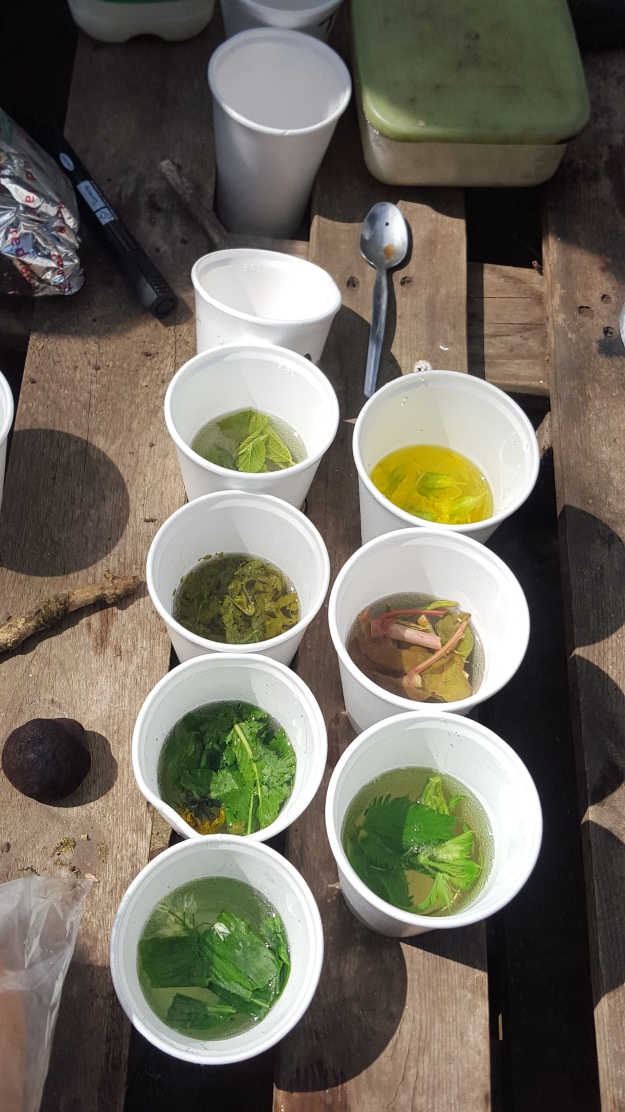
Our mid-morning snack: warm bread fresh from a Dutch oven with freshly picked wild garlic.
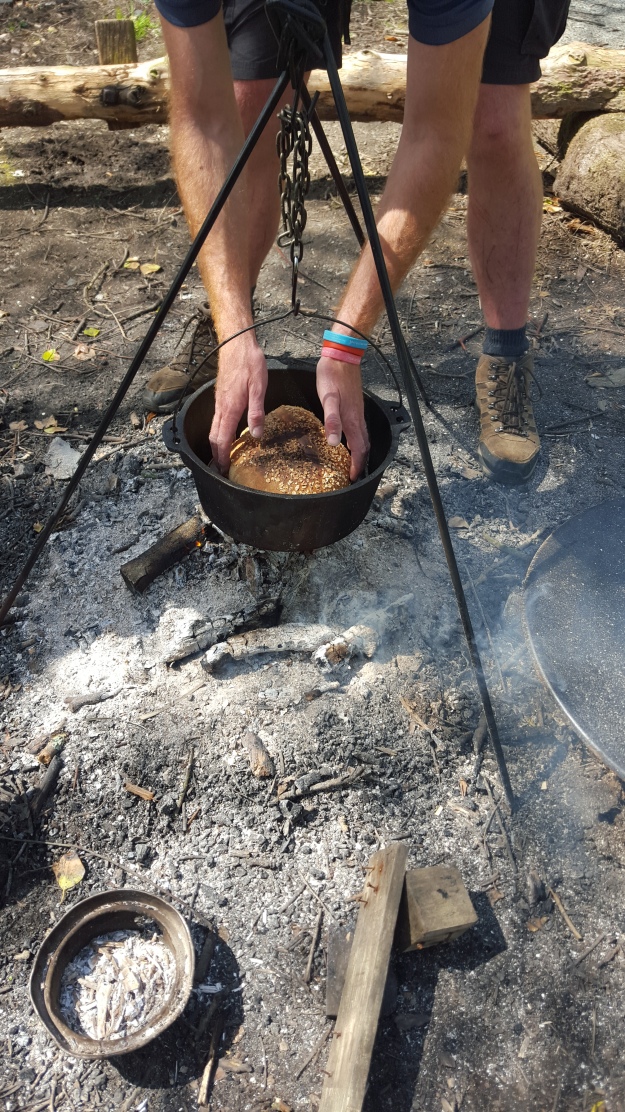
We used a participatory voting method – ‘pebble voting’ to decide which of the teas tasted the best (dandelion seemed to be the most popular).
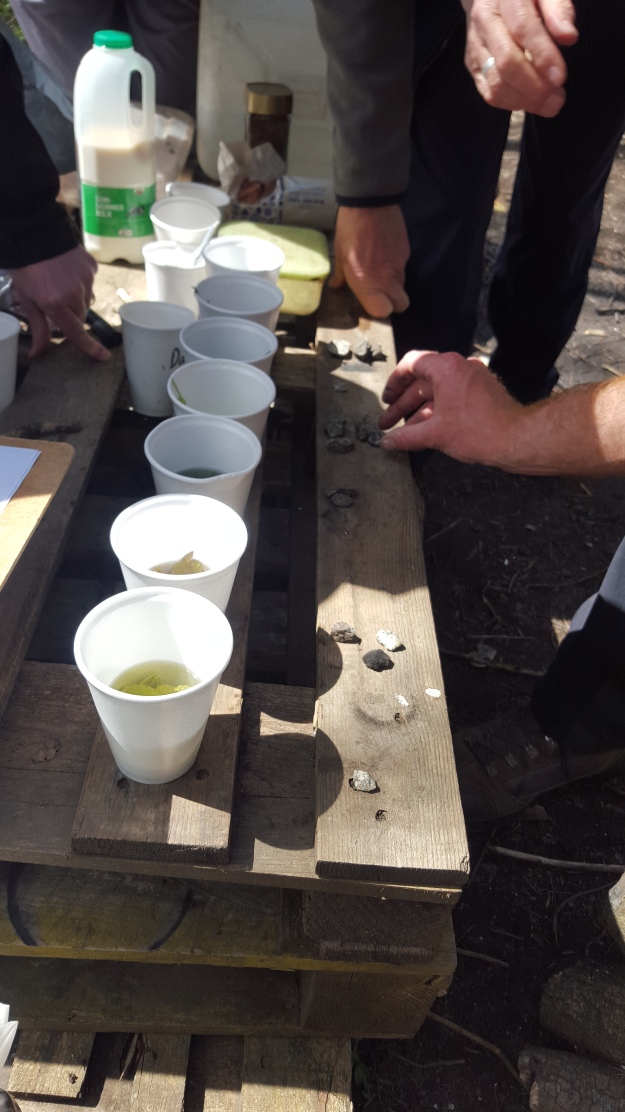
It wasn’t just tea-testing, cows and pretty walks however; the topic of the networking meeting was behaviour change. Participation Cymru posed the question for organisations who are implementing the National Principles for Public Engagement in Wales: what behaviour change has to take place within an organisation? Answers on a magnetic whiteboard…
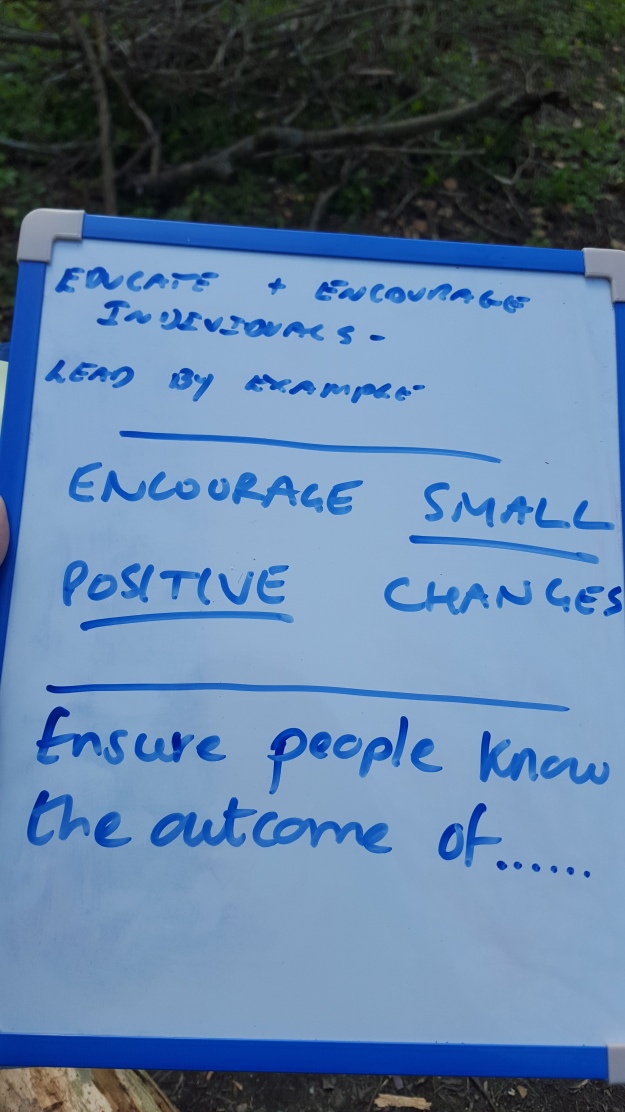
We recently published a checklist of implementation for the National Principles with questions relating to each principle. Has your organisation had to change its behaviour when engaging? Have you had to try to influence the behaviour of others in order to make improvements? Join the conversation but leaving a comment below.
Finally…leave (almost) no trace
This water soluble air-drying clay is an excellent way for people to ‘leave their mark’ in nature without causing any damage to the environment. We took all of our rubbish with us.
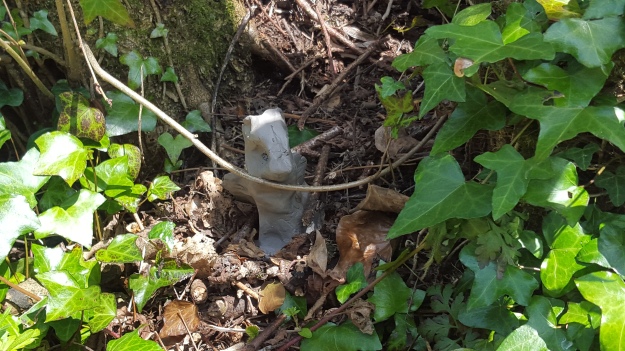
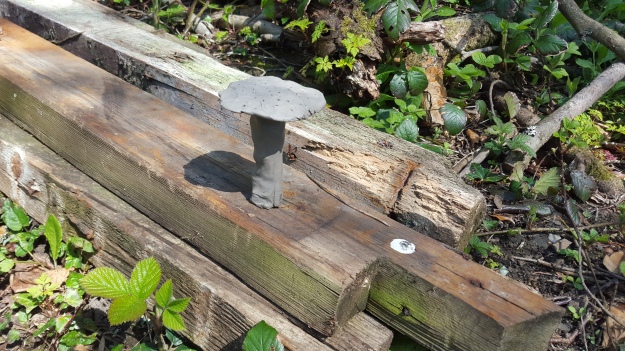
Many thanks to Tom, Jill and Matt from Pembrokeshire Park National Park Authority who helped make this event a success.
Are you thinking of holding a community event or meeting outdoors in Wales? If you are, please tell us so we can help you promote it.
Keep checking our website for details of future network events.
Our ‘All Wales Network event’ entitled ‘Engaging with diverse communities’ is taking place in Llandrindod Wells on 14th July it’s FREE to attend!
– Sarah
Presentations created using PowerPoint have been a large part of the business world for the past 20 years. A presentation is a speech that’s meant to inform, persuade or build good relationships; the slides that appear behind the speaker are there to compliment their words. The concept of presenting in this style is here to stay, but why do traditionally styled presentations seem so boring these days?
So often, slides will contain things likely to cause the audience to quickly lose interest:
All of these common features seen in presentations have helped coin the phrase ‘death by PowerPoint’ .
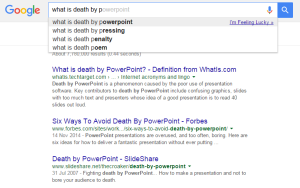 The BBC’s article How to avoid ‘death by PowerPoint’ lists some of the overused and almost cringe-worthy clichés that you’ve quite likely had to sit through with stifled yawns at some point during your life.
The BBC’s article How to avoid ‘death by PowerPoint’ lists some of the overused and almost cringe-worthy clichés that you’ve quite likely had to sit through with stifled yawns at some point during your life.
But what are the alternatives?
Before you start designing slides, you need to recognise your own presentation style or rhetorical stance, identify the purpose of your presentation and most importantly: the needs of the audience you’ll be presenting to and how to get the message across in an understandable, engaging way. Do you even need slides or will your words be sufficient?
If you do opt for slides there are many alternative types of software to try if you want to avoid using traditional PowerPoint in your future presentations, there’s Prezi which is quite widely used – its key feature being its zooming user interface which allows you to zoom and rotate into each slide, but try not to overuse this feature.
There’s also Keynote for Mac and iOS. The latest version of Microsoft PowerPoint also has some exciting features such as its slide designer and 3-D animator.
Visual content
‘Frequently in good presentations, photos serve well in a metaphorical or conceptual sense, or to set a backdrop tone for what the audience is hearing from the presenter, and not necessarily to communicate actual content’. Aaron Weyenberg
One of my personal pet peeves with presentations is when the slides repeat – almost word for word – exactly what the presenter is saying. My personal choice is for there to be as few words on a slide as possible (preferably none at all). The photographs you choose as your backdrop will help set the tone for the point(s) you’re making so, whilst avoiding the clichéd thumbs up and cogs, this is also an opportunity to get creative with your visual content; find a free stock photo using Pixabay, create an info-graphic using Easel.ly or Canva or even take your own photographs to accompany your presentation.
It’s your performance!
Any form of presentation or public speaking requires you to perform and adopt a persona, mostly because it’s a daunting task and even the most experienced of public performers will get nerves – this is completely normal. A good idea is to concentrate on your body language – social psychologist Amy Cuddy’s research shows that by standing in a posture of confidence can affect certain neurotransmitters in our brain and have an impact on our chance of success, even if we’re not feeling particularly confident at the time – the important thing is to act confident.
Don’t forget what makes your heart sing
If you’re passionate about the topic you’re speaking about then this will show. Steve Jobs says “Be authentic: don’t let the noise of other’s opinions drown out your own inner voice” – get inspired by your topic in order to inspire your audience.

Photo credit: tamsininnit
We recently held a training course ‘Designing and delivering brilliant presentations’ with the aim of developing skills in creating and delivering presentations that will make a real difference. The learners will also have a chance to design their own presentation and attend a follow-up session with their fellow learners, deliver their presentations and gather feedback. We can also deliver this course in-house for organisations; get in touch to discuss your learning needs.
Have you got any other tips for designing or delivering presentations? Please leave a comment below to share your ideas and experiences.
– Sarah
As well as being Participation Cymru’s Adminstrator, I am also the lead on the protected characteristics of pregnancy and maternity under the Equality Act 2010. I am the proud mother of a lovely one year girl and was adamant from the start that I wanted to return to work, largely so that she would grow up knowing that she does not have to choose between a career and a family, and so this topic is close to my heart.
I considered myself fortunate during my own pregnancy and subsequent maternity leave to be working for an organisation that treats pregnant employees fairly – in fact I disclosed my pregnancy during my job interview and was not hindered by this! I chose to take six months of maternity leave and was able to fully appreciate and use this time to bond with my daughter in the knowledge that my position at work would be secure at the end of my leave. Moreover I was only contacted socially by my team during my leave and was given support and supervision on my return to help me get quickly back up to speed with things.
My own situation should be considered the norm and not an example of good fortune. Unlawful discrimination against pregnant employees is well documented however, and every year many women have very different experiences to the one I described. One in nine new mothers are discriminated against or dismissed from their employment in the UK. While men are often seen as more responsible at work when they become fathers and can benefit from increased responsibility or promotion, women can and do suffer from being perceived as less capable and less reliable when they become mothers. This is not only an unfair assessment of the abilities of individual women in their careers (not to mention the contribution of fathers) but also damages workplaces if talented women choose to leave.
I asked some other women about their own experiences of returning to work following maternity leave and what their workplace had done to make that transition as easier. Here is what they had to say:
I recently attended the All Wales Maternity Network, a forum for service users to contribute to the improvement of maternity services in Wales. During the introduction I learned that most changes to these services have come about as a direct result of challenges by service users – our right to give birth in a hospital and to have access to an epidural are a result of demands by mothers.
Workshop: why do we need a strong service user voice? @1000LivesPlus @ClaireRoche5 #MaternityNetworkWales pic.twitter.com/LwNVpEIRq9
— Bethan Downes (@Bethanwy_88) November 23, 2015
While it was certainly positive to be part of a meeting of parents and professional (most people present were both) who were determined to improve maternity services, the number of people who shared distressing experiences that could have been avoided was disheartening. One common frustration that emerged was that mothers felt that they had not been provided with enough information to feel that they were making informed, empowered choices about the options available to them regarding where and how they chose to gave birth. Further to this many women were unaware that they had a choice in certain matters – the language used by some health visitors and midwives implied that these women were being instructed instead of advised and there was no opportunity for discussion. These issues are equally relevant for mothers choosing to return to work – if we are to insist on fair treatment it is imperative that we know what our rights in this area are.
Find out more about how to get involved with Maternity Network Wales.
– Non
If you’ve never come across the concept of Open Space Technology before and you’re familiar with a formal style of hosting meetings, it can seem quite daunting to have to facilitate or even participate in a session that uses Open Space.
This style of facilitating fits our ethos
Our ethos is that ‘We work with people and organisations and not for them’.
Open Space Technology is a style of facilitation that allows a group of individuals to be completely self-organised in reaching goals. This is achieved with barely any input from the facilitator, who will do little more than outline the guiding principles of Open Space Technology, introduce the over-arching topic/theme/purpose of the meeting and then let the group get on with it. This technique has been used around the world in meetings of 5 to 2000 people.
There is no formal agenda and no ground rules, except for the Law of Two Feet, that is: “If at any time during our time together you find yourself in any situation where you are neither learning nor contributing, use your two feet, go someplace else.” (Harrison Owen)
Owen’s Tedx Talk ‘Dancing with Shiva (or Sandy, or Katrina)’ is a great starting point for any facilitator or practitioner interested in this method.
We’ve used this technique at several network events
We’ve used this technique several times including at our All Wales Residential Network in 2012, during a session at WCVA’s annual staff day and most recently at our Regional Participation Networks in October.
Topics being discussed at the North Wales Participation Network #OpenSpace pic.twitter.com/cNconvTt7K
— Participation Cymru (@PartCymru) October 14, 2015
This technique is excellent because it really allows anyone who attends a session to speak about what they want. Open Space gives people a platform to do this without a facilitator poking their nose in (as it may be perceived) if a conversation goes off-topic or a discussion changes course, therefore shifting the power away from one person and sharing it amongst a group.
We’ve always had success using Open Space, at our most recent participation network events there was a wide variety of topics that people brought to the meetings that we held in Rhyl, Barry and Carmarthen this October:
The online community
There is a huge online community for facilitators and practitioners who use or are interested in Open Space Technology, which includes a very active e-mail discussion list and a Google Group – no organisation or individual owns or controls this collective information and it truly is an ever-expanding knowledge-base. I’ve been part of the e-mail discussion list for just over a month and although I haven’t contributed anything, during my time spend ‘lurking’ I have learnt so much about situations where Open Space has been used successfully. Anyone can read the archives from this list, which date back almost 20 years so there is a huge amount of user-generated information there!
It’s fun
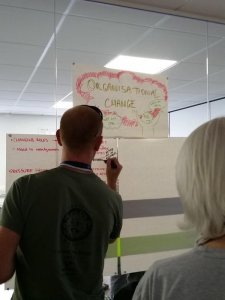 As a facilitator, it’s great to look around the room and observe meaningful, organic and productive discussions which are taking place.
As a facilitator, it’s great to look around the room and observe meaningful, organic and productive discussions which are taking place.
As a participant, it’s wonderful to have the opportunity to talk about things in an informal environment. Even with careful facilitation with lots of open questions asked it can still be difficult to get your point across if other participants have a louder voice than you. In an open space environment, participants can use the law of two feet to move away from unproductive discussions.
Have you ever used Open Space Technology in your engagement work? Have you ever attended a session? Please share your experiences in the comments section below.
– Sarah
I recently attended a meeting of the Patient and Public Interest Group (PAPIG), which is made up of patients, carers, patient advocates and third sector organisations. The group feeds their views via the All Wales Therapeutics and Toxicology Group (AWTTC), who provide professional, technical and administrative support to the All Wales Medicines Strategy Group (AWMSG). One of the roles of AWMSG is to advise Welsh Government whether new medicines should be available for use in NHS Wales.
New medicines are evaluated against currently available medicines to compare:
AWMSG is committed to involving patients, carers and members of the public when evaluating new medicines. During the appraisal process, the patient and carer view is critical because clinical data alone can’t quantify a patient experience – the patient needn’t be an expert in medicine in order to be involved in this process. Most of the questions asked of them during the appraisal process are related to their condition and how it affects their day to day life.
The patients and carers who contribute may not be scientifically or clinically trained, but they certainly hold invaluable knowledge about the impact that their condition has on their and their families’ lives. Other stakeholders such as pharmacists, academics, clinicians and industry representatives are also involved throughout the process. The patients and members of the public are found through patient advocates and third sector organisations that are represented on Patient and Public Interest Group. AWTTC also search for other patient groups in order to reach those who are not currently engaged in this process.
It’s worth noting that other bodies in the UK who appraise new medicines do not take responses from individual patients or members of the public, but AWMSG do.
Patients and members of the public who are involved are known as lay-members. The dictionary definition of a lay-member is “A person who does not have specialised or professional knowledge of a subject.” So if this is what a lay-member doesn’t have, what about the skills that they do have?
At the meeting, we completed a participatory exercise to examine ‘what skills, experience, qualities and attributes does a lay member have?’
Here’s some of what we came up with:
Qualities and attributes
Completing this visual exercise was very a thought-provoking and interesting way of looking at the lay-member role.
What participatory tools have you used to analyse the roles of citizens involved in your consultation process?
At the All Wales Participation Network this year, Joe Powell set the tone with a powerful opening speech about the importance of full participation in society for people with learning disabilities. Joe was diagnosed with Asperger’s Syndrome in 1996 and has spent 11 years in social care. He is now National Director of All Wales People First; a group uniting the voices of self-advocacy groups in Wales. Joe drew on his first hand experience of fighting to leave a system that was determined to see him purely as a service-user, someone needing assistance, and not as someone who also had a lot to offer to his community.
Joe began his talk by outlining ‘The good life model’; values that are important to the people with learning disabilities Joe has spoken to. These values included ‘loving and caring relationships’, the choice that is derived from having some wealth (implicitly this includes control over one’s financial assets), a ‘contributing place in the World’ and ‘a home of my own’. The first thing that struck me was how similar they are to what a non-learning disabled person wants from their own life – these values seemed universal, as opposed to learning-disability specific. All of the values were, to my mind, underpinned by a balance between personal safety and security on one hand and on the other a sense of being able to take agency over one’s own life and further, contribute something to the lives of others. Isn’t this what everyone wants form their lives?
Many people with learning disabilities also have a visual impairment and some of these people were not taught to read at school. Simple measures such as offering easy-read information and audio format can make it possible for people with learning disabilities to access information without having to rely on a friend or carer to read it to them. This allows people to maintain a sense of independence and dignity, rather than become institutionalised, especially where the information concerned is of a private nature.
Given that what people with learning disabilities want is so similar to what the wider population aspire to, one could be forgiven for assuming that these desires are readily accommodated in learning-disability care and are empathised with by society. However, Joe explained that in reality people with learning disabilities are effectively ‘retired at the age of eighteen years’; rarely in employment and often even excluded from volunteering. The mentality behind such sidelining appears to be that anyone with a learning disability is a ‘service user’ and therefore in need of assistance. Whilst many people with learning disabilities are indeed users of services, this does not mean that they are not capable and eager to give assistance in their communities and contribute meaningfully not only to their own lives, but also to the lives of others.
This restriction in participation is not only a massive loss in terms of potential volunteering and employment opportunities but also completely contrary to the principles of the All Wales Strategy 1983. The strategy stipulates that people with learning disabilities have the right to choose their own patterns of life within their communities and to access to professional services where additional help is necessary for them to achieve this.
People with learning disabilities largely DO want to work and to volunteer, said Joe, and we need to make more of an effort to accommodate their needs in theses capacities. Prejudice stems from ignorance and when people with learning disabilities are visible in useful roles, this will make it harder to stereotype them as a burden and give credibility to their voices.
Joe’s closing remark, before inviting questions from the floor, was that participation for people with learning disabilities must be realistic and never tokenistic. We must make it possible for people with learning disabilities to enter the workforce with reasonable adjustments made if necessary only when they are capable of fulfilling that role.
If you would like to hear more from Joe Powell, you can keep up with Joe’s Soapbox.
The ‘Storify’ for the day, including Joe’s presentation, other resources from the event as well as delegate’s contributions via social media is available here.
– Non
Every month we feature a participatory method/tool in our newsletter and I am always thrilled to have such positive feedback and am frequently told by readers that they really look forward to see what the ‘Method of the month’ will be! As a result we thought it would be a nice idea to turn this feature into a monthly blog post in order to (hopefully) reach more people.
We always welcome suggestions and photographs of participatory methods that other organisations have been using, so please get in touch if you have a technique you’d like to share!
An archive of past newsletters is available on our website.
Last month’s featured method is…
Evaluation thermometer
This is a visual, participatory evaluation technique that could be used to evaluate a meeting, event or focus group. Participation Cymru recently used this tool to evaluate the regional participation networks that took place this month.
Tools needed: Flipchart paper, coloured marker pens and sticky dots.
Preparation: Draw a large thermometer onto the flipchart paper. The top should represent heat (excellent/great), the middle should be lukewarm (reasonable/OK) and bottom should be cold (disappointment/dislike).
Choose what you’d like people to rate, e.g. overall impression, how participative the event was etc.
Give sticky dots to participants and ask them to stick them where they feel they should go on the thermometer and take photos of the results.
– Sarah
Elections are the primary way for us to express our reactions to the performance of the government. An election is a tool of communication between the representatives and us: the people they represent.
Apparently, voters get the government they deserve. This implies that active participation by the electorate on polling day will result in us getting a government which truly represents its people but most of us will argue that the current coalition government doesn’t match that assumption. Only 65.1% of the electorate voted in the 2010 general election and it’s fairly obvious that more people voting could have resulted in an entirely different outcome.
Our participation in elections is without doubt an important responsibility and a significant symbol of our democracy and participation in public affairs.
Marking your ‘X’ on the ballot paper may seem like a small thing to do, we can of course participate in politics and public services in many different ways and not just at election time. However, the right to vote (that people have fought and died for) symbolises democracy and fair culture and I believe it is our duty to ourselves to have our voices heard in this process.
The way that candidates campaign and communicate with us has drastically changed. Paid-for political advertising is banned on television and radio in the UK, so a typical election campaign (in my mind) consists of hopeful candidates knocking on doors and shaking hands while proudly wearing shiny coloured rosettes and covering our doormats in glossy literature telling me that “the other candidate wants to sell the NHS” or “vote for him and he will double your taxes”.
With the prevalence and availability of modern technology, social media and digital communications are at the heart of this year’s general election campaign.
As paying for adverts of TV is not allowed, candidates are allowed to pay for political adverts and videos online via social media, potentially reaching an audience of millions and Ofcom do not regulate what is posted on these platforms. This provides an opportunity for much broader and more authentic, genuine and honest conversations to take place between the candidates and the voters. Facebook even has its own checklist for political candidates to refer to when posting updates – but are they using this to its best potential?
The evolution of social platforms between 2010 and 2015
5 years ago, the political parties were newly launching themselves on Facebook, getting their party leaders online and ensuring they had some sort of ‘presence’. Now it’s 2015 and social media has evolved so much in the last 5 years and so has the way that we use it.
Local candidates and parties should by now be using social media as a platform to have genuine conversations and engage with people so their presence online feels authentic and less like they’re just using a new and trendy tool.
Politicians traditionally use their public facing profile to get their message across and inform the public what they’re promising to change if they get elected. Candidates are now also using the platform to ask people for their opinion.
Hidden audiences and the ability to influence
The number of likes on a political candidate’s Facebook page is irrelevant when Facebook’s mighty algorithm allows networking and linking interests together; friends of friends of friends are being influenced by what appears on their newsfeed.
Obviously, some audiences are much less responsive to this method of campaigning. Some people don’t use the internet at all for example: television news and printed newspapers are still the most important news sources for certain audiences.
The role of the social networking movement in increasing electoral participation is not as simple as it may seem and ‘getting it right’ is never an exact science. Browsing through some candidates Facebook and Twitter pages – I’m surprised to see that most updates only point out the flaws in the opposition’s policies the potential for positive campaigning and conversations could be missed!
Addressing electoral inequality
The Institute for Public Policy Research (IPPR) have recently launched a report suggesting that voting should be compulsory for the first election after each person turns 18. They accurately report that ‘the working class and the young have less input into political decision-making processes‘ in comparison to older and more affluent groups of people and propose that forced participation may be the answer to this inequality.
The main issue with this is that you can’t force people to take an interest; you can’t force people to care about something if they don’t. Compulsory voting would be nothing more than an illusion of democracy – how can it be democratic if it’s forced? It can’t! If compulsory voting was introduced I can’t help but imagine a rise in the number of spoiled ballot papers or people being forced into voting for something with little information resulting in a system which is even less representative than it is now.
Surely it is also still important to monitor any disinterest and dissatisfaction. There are many very justifiable reasons for choosing not to vote; it could be that someone feels as if they’re not well enough informed, or that none of the candidates or parties accurately represent their views and some people are just not interested. It is important to monitor lack of activity at the polls and find out why this is happening instead of just forcing everyone to participate.
Principle #2 of the National Principles for Public Engagement is “Encourage and enable everyone affected to be involved, if they so choose.” Those last four words are central to the engagement process – giving people the option to be involved.
I will be voting in this General Election because I want to and it’s my choice to, as I mentioned earlier I feel that it is my duty to be involved but I respect and understand the views of those who don’t want to vote. No one should be forced into democracy – that would be a contradiction!
So, participating in elections is an important responsibility but our vote is not our only voice or is it our only opportunity to be involved in politics. Everyone has a right to be listened to and those in power need to listen to us, however we choose to be heard.
– Sarah
If you’re 16 or 17 years old – you may not be able to vote this time but you can still register. The National Assembly for Wales’ elections takes place in May 2016.